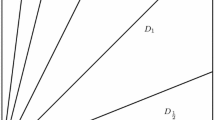Abstract
We characterize the existence of semicontinuous weak utilities in a general framework, where the axioms of transitivity and acyclicity are relaxed to that of consistency in the sense of Suzumura (Economica 43:381–390, 1976). This kind of representations allow us to transfer the problem of the existence of the \({{\mathcal{G}}{\mathcal{O}}{\mathcal{C}}{\mathcal{H}}{\mathcal{A}}}\) set of a binary relation to the easier problem of getting maxima of a real function. Finally, we show that the maxima of these representations correspond to the different levels of satiation that each of individual has (an individual reaches his or her level of satiation when an increase of consuming an alternative product/service brings no increase in utility).
Similar content being viewed by others
References
Alcantud J. (1999a) Topological properties of spaces ordered by preferences. International Journal of Mathematics and Mathematical Sciences 22: 17–27
Alcantud J. (1999b) Weak utilities from acyclicity. Theory and Decision 47: 179–190
Alcantud J. (2001) Orderability of topological spaces by continuous preferences. International Journal of Mathematics and Mathematical Sciences 27: 505–512
Alcantud J. (2002) Characterization of the existence of maximal elements of acyclic relations. Economic Theory 19: 407–416
Alcantud J., Rodriguez-Palmero C. (1999) Characterization of the existence of semicontinuous weak utilities. Journal of Mathematical Economics 32: 503–509
Banerjee A., Pattanaik P. K. (1996) A note on a property of maximal sets and choice in the absence of universal comparability. Economics Letters 51: 191–195
Bergson P. A. (1938) A reformulation of certain aspects of Welfare Economics. Quartely Journal of Economics 52: 310–334
Birkhoff G. (1948) Lattice theory. American Mathematical Society Colloquium Publication, New York
Bridges D. (1983) Numerical representation of intransitive preference on a countable set. Journal of Economic Theory 30: 213–217
Chateauneuf A. (1987) Continuous representations of a preference relation on a connected topological spaces. Journal of Mathematical Economics 16: 139–146
Debreu G. (1954) Representation of a preference ordering by a numerical function. In: Thrall R., Coombs C., Davis R. (eds) Decision processes. Wiley, New York, pp 159–166
Debreu G. (1964) Continuity properties of Paretian Utility. International Economic Review 5: 285–293
Doignon J., Ducamp A., Flamagne C. (1984) On realizable biorders and the biorder dimension of a relation. Journal of Mathematical Psychology 28: 29–62
Donaldson D., Weymark J. A. (1998) A quasi ordering is the intersection of orderings. Journal of Economic Theory 78: 382–387
Duggan J. (1999) A general extension theorem for binary relations. Journal of Economic Theory 86: 1–16
Eilenberg S. (1964) Ordered topological spaces. American Journal of Mathematics 63: 39–45
Fishburn P. (1970) Intransitive indifference with unequal indifference intervals. Journal of Mathematical Psychology 7: 144–149
Fleischer I. (1961) Numerical representation of utility. SIAM Journal of the Society for Industrial and Applied Mathematics 9: 48–50
Herden G. (1989) On the existence of utility functions. Mathematical Social Science 17: 297–313
Herden G., Pallack A. (2002) On the continuous analogue of the Szpilrajn Theorem I. Mathematical Social Science 43: 115–134
Jaffray J.-Y. (1975) Semicontinuous extension of a partial order. Journal of Mathematical Economics 2: 395–406
Peleg B. (1970) Utility functions for partially ordered topological spaces. Econometrica 38: 93–96
Peris J., Subiza B. (1995) A weak utility function for acyclic preferences. Economics Letters 48: 21–24
Rader T. (1963) The existence of a utility function to represent preferences. Review of Economic Studies 30: 229–232
Richter M. K. (1980) Continuous and semicontinuous utility. International Economic Review 21: 293–299
Samuelson P. S. (1983) Fountations of economic analysis (enlarged edition). Harvard University Press, Cambridge
Schwartz T. (1986) The logic of Collective Choice. Columbia University Press, New York
Subiza B., Peris E. J. (1997) Numerical representation for lower quasi-continuous preferences. Mathematical Social Science 33: 149–156
Suzumura K. (1976) Remarks on the theory of collective. Economica 43: 381–390
Suzumura K. (1999) Paretian welfare judgements and Bergsonian Social Choice. Economic Journal 109: 204–220
Suzumura K., Xu Y. (2003a) Recoverability of Choice Function and binary relations: Some duality results. Social Choice Welfare 21: 21–37
Suzumura K., Xu Y. (2003b) On constrained dual recoverability theorems. Mathematical Social Science 45: 143–154
Author information
Authors and Affiliations
Corresponding author
Rights and permissions
About this article
Cite this article
Andrikopoulos, A. Characterization of the existence of semicontinuous weak utilities for binary relations. Theory Decis 70, 13–26 (2011). https://doi.org/10.1007/s11238-010-9222-7
Published:
Issue Date:
DOI: https://doi.org/10.1007/s11238-010-9222-7




